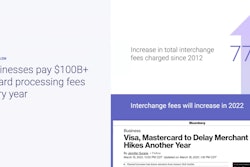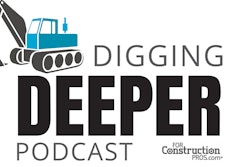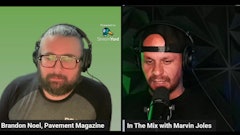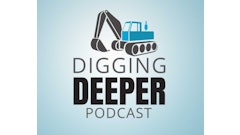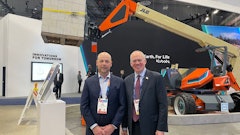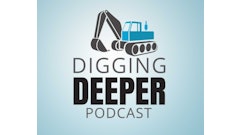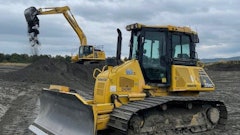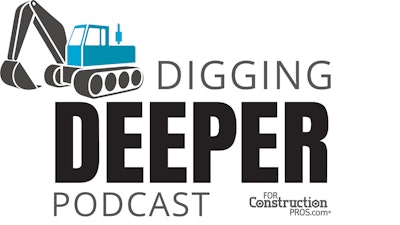
Want to learn how to manage your cash flow and improve profitability at the same time? On this Digging Deeper podcast Shawn Van Dyke, construction industry consultant, not only explains how the two work hand-in-hand but what contractors can do to take advantage of this important relationship.
Allan Heydorn: Hello construction company owners and managers, I’m Allan Haydorn, editor of Pavement Maintenance & Reconstruction and conference manager of new Ignite Construction Summit which will be held December 12 and 13 in Las Vegas.
With me is Shawn Van Dyke, a 20 year veteran of the construction industry, who will be one of seven presenters at Ignite. Shawn will be wrapping up the second and final day of the program with his session titled “Profit First for Contractors: How to Guarantee Profits and Manage Your Cash at the Same Time.” And we’re going to talk a little bit about that today.
Welcome Shawn, it’s great to talk to you.
Shawn Van Dyke: Hey Allen, thanks for having me on, I really appreciate it.
Heydorn: Would you like to give a brief bit of background for the contractors out there who might not know you?
Van Dyke: Yeah, it’s a bit dangerous to give my background because I started out as an engineer, so I got a couple degrees in engineering. I know what all contractors think about engineers, so that kind of puts me out on the wrong foot. But I did engineering for a while. I was a civil and structural engineer. Then I realized that sitting behind a desk, I didn’t really know how to build anything.
So I left engineering, got into commercial instruction, did project management for large commercial contractors for a few years. That lead into real estate development. I became a construction manager for a real estate developer, and I did that for a few years. That put me on the road quite a bit building large retail developments.
I was newly married at that time and had my second kid on the way, and my wife was like, it’s a great job, but you’re going to suck as a dad, so you need to find something that isn’t going to have you on the road two or three days a week.
So I started my own real estate development and construction management firm, did that for a few years, and then the downturn of the economy shifted. I started a residential contracting company and did that for several years. I partnered with a friend of mine and was the COO of a large trim and millwork company, and I did that for four years. Then I started what I’m doing now: the speaking, consulting and coaching business. Now I work with contractors all over the United States to help them run a better business and make more money.
Heydorn: Well, obviously we’re glad to have you at Ignite, and it sounds like you’re a perfect fit. You’re able to come at this from quite a few different perspectives.
Van Dyke: Yeah, at one time, back when I was switching jobs and always keeping my resume up to date, about 10 to 12 years after college, I was looking at my resume. I showed my wife and said, “Hey honey, this is kind of impressive. I’ve got a lot of good experience.”
And she took one look and said, “Or it looks like you can’t keep down a job.”
And I was like, well, that depends on how you look at it. But yeah, I’ve been around construction for over 20 years now, gosh, it’s crazy to say that. And looking back on it, I can see how every opportunity and one job led to the next. And I never would have put it together this way, but I’m so thankful for my experience. I’m really happy to be able to bring that amount of experience to my clients and the contractors I work with.
Heydorn: Well, we know that experience is going to carry through when you present at Ignite. Let’s talk a little bit broadly at the start. You know, your book “Profit First for Contractors” is designed to help contractors become “permanently profitable” because that’s the term you use -and I think that book has spent some time at the top of Amazon’s financial book list, so congrats on that.
Van Dyke: Yeah, thank you.
Heydorn: You use the abbreviation PFC (Profit First for Contractors) and you’ve developed what you call a PFC mantra - that profit is not an event, it’s a habit. I’m going to ask you to elaborate on that in a second, but can you tell us where that idea came from? I mean, what did you do along the way that made you to realize contractors treat profit as more of an event more than a habit?
Van Dyke: Yeah, well it really came from an experience I had while running my construction business. And any contractors out there, I’m sure they’ve had the same experience. You spend a few years getting up and going, you start getting more work, your name gets out there, and your reputation grows.
Then a few years go by, and money’s coming in and money’s going out, and you don’t know all the financial stuff.
But you think, “Hey, I must be making money,” and you’re constantly checking the bank account. There's some money there, or there’s more money here than I’ve ever seen there, and then it disappears and comes back. So then, somewhere around February or March you have that conversation with your accountant. And your accountant says “Hey, congratulations, you’re profitable”
So you say, good, I hope so. But then they say, “And you owe the government $20,000,.” And you’re like, wait a minute! How can I owe the government $20,000? I’m looking at my bank account, I’m looking at the bottom of that profit and loss statement. I don’t have $20,000.
You start to realize that, wait a minute, all that money coming in isn’t really my money. It took several years into my business to realize this. I don’t know all of that complicated tax stuff, but I know that I had this amount in revenue last year, and I ended up owing a big chunk of money to the government. So, going forward, I’m going to take that amount of money that I owed to the government and divide it by my income. I’m just going to guess that if I can increase my margins and do better next year, then I’ll most likely owe the government even more money.
I’ll just come up with a simple percentage and set that aside, at least from my taxes, every time I get a check. And the next year went by, I was just doing that, and I didn’t understand the complicated tax laws. But I knew the percent. Every time I received a check, some portion of that was the government’s, and I stuck that aside. I didn’t do any complicated financial calculations. The next year went by, and I had a conversation with my CPA, and he said, “Shawn, I’ve got some bad news for you, you owe money to the government.”
So I asked how much, and he told me I owed $5,000. But I said that’s great, I’ve got that sitting in the bank! I had a better year that year, I upped the percentage I was sending to the government every quarter, and I was sticking some more aside. So what he thought was bad news, I said was no problem because I’ve already got that sitting aside. It solved one of the biggest problems for contractors, which is understanding the taxes.
Again, I didn’t know the complicated financial stuff or the tax laws, but I knew that this year I paid x amount in taxes and that was a certain percentage of my money. So then, next year I’ll sit that same percentage aside, or maybe more if I plan on doing better, and that served me year after year. I never had to worry about taxes again.
And my accountant made some adjustments and tweaked some things, but in general the money was always there. So I started treating other aspects of my business in the same way.
Heydorn: So it was the repetition and the action that then made it a habit?
Van Dyke: Yeah! And so, I wish that I could say I was smart enough to develop what’s known as the Profit First Method. I didn’t come up with that, I just translated it into the book for contractors. My friend and my mentor, Mike Michalowicz, developed the system, Profit First.
And when I read his book and went through that system, I thought, “Wow, this is exactly what I teach my clients and exactly how I look at my business in the Profit First way. It’s just marketed and packaged better.”
So I kind of tweaked the way I was running my business and what I was teaching my clients to fit the Profit First, because it was essentially the same thing. I was just translating what came out of the Profit First model that was written for general businesses and made it very specific to the construction industry and went through the certification program it takes to be a Profit First professional.
I spoke to Mike, and I said this book would really serve contractors. There are a few changes that need to be made to it so that they would understand the specifics in the construction industry, and here’s how I would change the book. And Mike said, “Well, why don’t you just write the book?”
And I thought, is that how you write a book? You just take someone else’s idea and translate it? And he said yeah. Then we worked out a deal. He said he wanted me to take Profit First and develop it specifically for contractors. And he said that we had about three or four months to do it.
So I started rewriting the book, taking the Profit First system and developing it specifically for contractors, and that’s what you see out there today. I think because contractors are desperate for this information - not that they can’t do the financial stuff - they just need someone or someway to translate it that makes it very easy for them, and that’s what I break down in the book. You only have 100% of your budget to spend. If you spend more dollars than 100%, you’ve got some problems.
So every check that you receive, that’s where we get into the system. Some of that money is your profit. And we want to set that money aside first. That’s where the name comes from. We set the profit aside, and when we make a profit, then we’re going to pay some taxes. So we need to set a certain percentage aside for that.
Now that we’ve got those two very important things taken care of, we need to set some money aside for the owner’s compensation. And that’s a real struggle for most construction business owners is that they're not paying themselves what they’re worth. If they couldn’t work, they couldn’t afford to hire somebody at the level they’re paying themselves. So we solved that problem, too, and we set some money aside for owner’s compensation.
Now that we’ve got the most important things dealt with first in our business - profit, tax and owner’s compensation, then what we have left over is what we call our operating expenses or “op-ex”. And if there’s not enough money left over in the operating expenses, we don’t steal it from our profit, tax or owner’s compensation. Those things are why we went into business. Well, we don’t go into business to pay taxes, but it’s just a result of making a profit. So if we don’t have enough money left over to pay our expenses, we don’t steal it from those other accounts, we change the way we operate our business. We raise the price…
Heydorn: So the accounts essentially become fixed accounts then?
Van Dyke: Yeah! And so every single financial report from the accounting world is set up with this equation. It’s a very simplified equation: sales minus expenses equals profit. And that’s how your profit and loss statement is set up, cash flow statement, balance sheet. The money that comes in, that’s where we start. We spend a lot of money running the business, and the money left over is what we call profit. And unfortunately, it works very well mathematically, but it doesn’t work at all when we consider human behavior. Because contractors and most other business owners don’t run to their spreadsheets, or their profit and loss statements, or their balance sheets to figure out how much money they have. What do you think they do? Where’s the one place everybody goes to to see how much money they have right now?
Heydorn: We go to the bank.
Van Dyke: We go check the bank account. That’s right! It tells the real story. And the thing about the accounting world, I’m not saying it’s wrong - mathematically it’s correct - but it doesn’t match our human behavior. So when we run to the bank account, that tells the real story. I’ve got money in the account. I can make payroll; or I’ve got money in the account I’ll buy that tool or that equipment, or I’ll rent a bigger shop because I can see the money right there. That tells the real story. No one goes to their profit and loss statement, especially construction business owners because the profit and loss statement is open to interpretation.
A lot of contractors I know have looked at their profit and loss statement and see a positive number on the bottom of that, but then they go to their bank account and say, I don’t understand where the money is. And accountants will tell you that the profit on the profit and loss statement is just profit on paper. You didn’t actually make that much. Then they throw their hands up in the air and say that they can’t figure this stuff out, so they’ll just live out of their bank account.
So Profit First for contractors actually leverages what’s a bad habit and makes it a good habit. But what we have to do is set up these accounts, we set up these different bank accounts, and everytime we get a check we take our profit and we set aside and protect it. Now we set aside some taxes and we protect it in a different bank account, and then we set aside some owner’s compensation.
Then when we check the bank account and we’re looking at the operations account, or the op-ex account, that’s the money we have to spend. And when we don’t have enough money to spend, we go out, we generate more business, we get more efficient, we trim the fat and we increase our margins for our business. So it takes what is a bad behavior, which is called bank balance accounting, “Oh, do I have any money, good I have some money, let’s go spend it.” And when I don’t have any money, “oh crap, what am I going to do?” I go and generate more business, I put on a spending freeze, I start figuring out ways to get by.
And if we can figure out how to get by on less when the bank account is low, then that’s how we should operate all the time. And if we can set our profits aside first, our taxes and owner’s comp - these important things - then our businesses become very efficient. And we realize that we still need to do the accounting, we still need the accountants and bookkeepers to do that, but we can manage the cash by what’s called bank balance accounting. It goes along with how human brains are wired. We go to the easiest thing first, and we know the money in the bank account, that tells the real story.
Heydorn: And you’re going to be talking about how to set up and evaluate those financial reports when you speak at Ignite, aren’t you? I think that’s one of the big points you’re going to be talking about.
Van Dyke: Yeah, that’s one of the big keys there to say, okay, here’s what you’re financial reports are telling you and what they’re not telling you. Also, here’s what the cash in the bank is telling you and the link between the two. Then we’re going to set up some rules to make sure that we’re leveraging our human behaviors, taking those bad habits and making good habits out of them. And the key is that we’re going to be starting very small. Small, consistent steps overtime lead to becoming permanently profitable.
Heydorn: Is there, in your consulting business when you’ve talked to all these different contractors, does there seem to be one major hurdle that gets in the way of contractors putting profit first?
Van Dyke: Well, yeah, I’ll say two of the most common things I run into. I no longer get surprised by the size of the company anymore. I used to be surprised when I talked to construction companies that were doing $10 to $12 million. Just because they usually have office staff that are educated in these things, but they still miss the most fundamental thing in the construction business and that is the difference between margin and markup.
They aren’t applying markup correctly to produce the margin they need, and they often use them interchangeably. So that’s the first problem that I usually work on explaining.
The second issue that I see, that we have to kind of correct, is that they get some advice from their CPAs. The CPAs say that they need to pay themselves, this is the owner, you should pay yourself through owner’s draws or owner’s distributions. And the CPA is saving them some tax liability there, but the problem is that owner’s draws or distributions don’t show up on the profit and loss sheet.
So if you’re an owner of a construction business, and you work in the business - let’s say doing business development, project management, estimating, design work, whatever that is - then if you’re compensating yourself through owner’s draws, then that amount doesn’t show up on the profit and loss statement. And the profit and loss statement is how you determine what the markup is and pay for your expenses – your margin - and have a profit remaining.
So that’s a big hurdle we have to get over to say hey, save some money, pay yourself through owner’s distribution according to your CPA’s advice. But understand that if you got hit by a bus and you couldn’t work in your business, and you’re laid up, you can still own the company from the hospital bed, you don’t have to work in the company to own it. But if your profit and loss statement – the way that you charge for your work - doesn’t compensate for someone doing the 17 jobs you do within your company, than you’re going to have to raise your prices from your hospital bed in order to hire that person that’s doing business development and estimating, and superintendent, and project manager.
And when they see that there’s some money on the balance sheet that doesn't show up on the profit and loss, they think they’re going to have to raise their prices by 20% or 30% in order to pay myself to properly compensate for the value I’m providing, and I say that’s exactly right. And they say that their clients don’t want to pay their prices now, they’re not going to want to pay 20% or 30% more.
That’s the key - we’re going to find you better clients. Because that’s the only way you’re going to stay in business and grow your construction business is to charge for the value of the work that you provide. And so many construction business owners are not paying themselves enough to replace themselves if they didn’t work.
Heydorn: Right, and so, one of the underlying themes of your consulting business and this session is to get contractors to understand that bigger isn’t necessarily better, is that right?
Van Dyke: Oh, yeah. Absolutely. I will talk to a lot of contractors and ask what their goal is for the next six to 12 months, and a lot of the time they’ll say growth. I wanna go. And I’ll say, why?
And I don’t mean that in a bad way, there’s no wrong answer there, but a lot of time contractors are chasing that top line number, the top line revenue. And that goes back to your original question that profit is not an event, profit is a habit. They think that when they get to be a $2 million company then I’ll be profitable, when I get to be a $5 million company, then I’ll be profitable.
And I think, if you’re not profitable as a $2 million company than there’s no way you’ll be profitable at $5 million because undisciplined growth will put you out of business just as fast as running out of cash. And that’s what we see a lot of times as we grow.
I’ve always said that I’d rather my clients run a $500,000 company making 6% net profit than $1,000,000 company making 3% net profit because the cash is exactly the same, but the headaches are probably quadruple.
A lot of times, contractors think of growth, growth, growth and more sales, more sales, more sales. But what they’re selling at the margins they’re selling aren’t enough to generate profit.
So, okay, if profit is not an event, someday in the future when this thing happens, then we’ll be profitable. If I can just hire some more people and have some more crews, then we’ll be profitable. If I can just get another truck on the road and staff it with people, then I’ll be profitable. If I can just get the right project with the right architect in the right area, then I’ll be profitable.
And I say, nope. Profit is never going to happen like that. You have to build profit into your business every month, every week, every day. Everything that you do has to generate a profit.
Because, sometimes mistakes happen, and we don’t always achieve those profits. So we need a profit built into everything we do constantly so we stay out of debt and then we can grow our business when we have cash. Or, another way to look at it is that, as we grow, we need a plan for profits so that as we scale up, we may need to finance certain expenses of our business. Maybe it’s equipment, maybe it’s property or something else. The best way to do that is with a proven plan for profits.
But a lot of time construction business owners skip over that and say that if I have a bigger shop, we’ll have more space and then I can make more profit. And if they’ve never had a history of making profit, then those expenses grow, the debt goes up, they get lines of credit, and then they turn around five years later and they’re still chasing that growth. And that one mistake, their one recession or their one correction, and one call from their accountant that say they owe $50,000 in taxes, and they don’t have the money, then they’re out of business.
Heydorn: Well, I know one of the goals of your session is to provide them with that proven plan to incorporate profit into everything they do. Let’s change directions a little bit here, and maybe it overlaps, I think.
I know you’ve authored another book called the “Paperwork Punchlist,” which is essentially a guide for contractors to help them streamline their operations. And I guess what I’m wondering, is there a relationship between what you teach in the “Paperwork Punchlist” and what you teach as your approach to profit.
Van Dyke: Yeah, it’s all connected. Business is business, and what I lay out in the “Paperwork Punchlist” I thought, what is the most valuable information that I could give to contractors to help them make money right now? I’m a systems guy, I used to be COO of a large construction company, so I’m a systems and numbers guy. And what I’ve found, I kind of stumbled upon this in my own construction company, is I got sick of just giving out a bunch of free work. And you see it plastered everywhere, “free estimates, free estimates.”
And what a lot of contractors do is give out free work instead of free estimates. An estimate is just a guess based on your experience. If you want me to come out, meet with you on site, put a plan together, give you options, go over all the different pricing, that’s work, and professionals get paid for work. So one of the things I’m trying to accomplish in the “Paperwork Punchlist” is to show contractors the difference between a free estimate and a proposal, and how quickly you can give a free estimate, if you know you’re numbers.
And say you looked at that project and say that that’s a $200,000 project, and you asked your client what’s their budget. And if they don’t give you a number, that’s okay. You’re a professional, you know you’re numbers and you know what the number needs to be because you’ve done this before.
It also gets into systems of tracking time and tracking your estimates and how to stop guessing on your estimates. I mean, when we start out we have to guess sometimes, but as we go forward and we start getting more data and more experience, we’re always looking back and reverse engineering our estimates to show exactly what we need to charge in order to make a profit. And that leads into Profit First, the same sort of thing where we’re reverse engineering our business in Profit First to match the money we have in our expenses.
Same thing with the “Paperwork Punchlist” is we’re using this data to track and estimate jobs to make a profit. So the “Paperwork Punchlist” was a very early attempt of me getting my name out there, adding a lot of value and breaking down, for contractors, my different experiences and some of the systems that I have built running my different construction businesses.
Like I said, I’m a numbers guy. I’m a spreadsheet guy. You just can’t know where you need to be if you don’t track time, materials and profit and look back to develop some historical data so that you can use those to project your prices going forward and to use those systems to constantly update and project where your business needs to be.
Heydorn: Well, I tell you, it certainly sounds like we’ve got the right guy to be anchoring the last day of that Ignite Construction Summit. And I look forward to talking to you there, and it was great talking to you now. As I recall, you’re going to be flying out from Boston to make it to Vegas for us, aren’t you?
Van Dyke: Yeah, well, fingers crossed everything works out. The day before that I’m going to be giving a speech, and literally as soon as I’m done with the speech I’m going to be hopping into the rental car, drive to Logan Airport, jump on the plane, fly out, and I’ll be appearing with you guys the next day. Fingers crossed all the weather holds up and the flights, but hell or highwater I’m going to get out there and make this event because I’m really, really looking forward to being out there.
Heydorn: We appreciate that, you know, I look forward to meeting you out there. And it was great talking to you today. This is Allan Haydorn for the Ignite Construction Summit. For a complete description of Shawn’s session as well as other Ignite details, visit www.ingiteconstructionsummit.com





